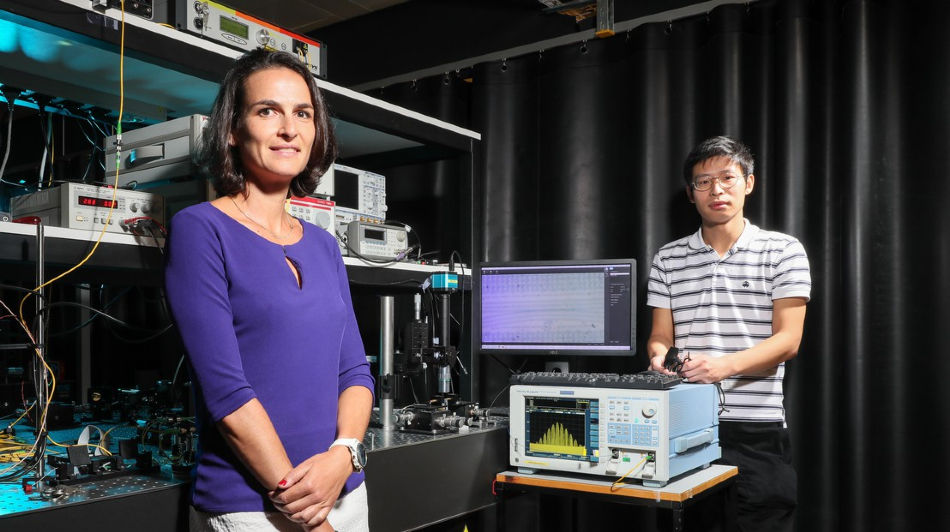Sep 8 2020
A team of researchers from the Photonics Systems Lab at EPFL has developed a new method to reconfigure microwave photonic filters without having to use an external device.
 Camille Brès and Jianqi Hu, authors of the Nature communication article. Image Credit: © 2020 Alain Herzog.
Camille Brès and Jianqi Hu, authors of the Nature communication article. Image Credit: © 2020 Alain Herzog.
This latest breakthrough may result in the development of more compact, eco-friendly filters that will be more viable and more economical to use. Promising applications of these filters comprise detection and communications systems. The latest findings were recently published in the Nature Communications journal.
Photons not only move faster but also consume minimal energy, and as such, they seem to be set to substitute electrons in an unlimited number of tasks. In addition, these small light particles are unexpectedly flexible—their frequency range is 1000 to 10,000 times larger when compared to that of electrons, which is an additional advantage.
Therefore, using light instead of electricity to exploit microwaves provides a relatively wider bandwidth to operate with. Furthermore, photonics proves to be quite handy in the Internet of Things, communications systems, and beamforming—a signal processing technique employed in antenna systems.
But even today, microwave photonic systems are incapable of producing light pulses on computer chips—an advancement that would render the chips cheaper, more eco-friendly, and more viable to use.
A research team from the School of Engineering Photonics Systems Lab at EPFL has made a significant innovation in this domain—they have created reconfigurable radiofrequency filters that are capable of producing high-quality microwaves without having to use a large external device.
When the researchers created an interference between a pair of pulses inside a microcomb, they were able to precisely manage these pulses to alter the outgoing radiofrequency.
Integrating a Light Source into a Chip
A microwave photonic filter is capable of changing an incoming radiofrequency into an optical signal. This signal can be subsequently processed by a photonic device to extract the data. Following this, a photoreceptor effectively transforms this optical signal into a radiofrequency.
Earlier in April 2020, scientists from the K-Lab, which is another EPFL laboratory, were able to create varied types of microcombs on a silicon nitride chip to generate high-quality soliton pulse signals.
In the end, all that was left in the experiment was to show that the soliton pulse signals could be utilized to reconfigure the microwaves and that the system was equally linear, flexible, noise-free, and spectrally pure as the earlier, larger devices—precisely what the team in the Photonics Systems Lab had made the chip to do.
The new technology applied in these chips, which are tinier than a coin, is built on the way light interacts with the surrounding setting. It is possible to alter the wavelength of the signal by changing the light source or by varying the material or shape of the optical channel it travels through.
Using a light source that can combine several wavelengths means that we can keep the filter’s structure quite simple. If we can reconfigure the frequency by altering the light pulse, we don’t need to change the physical support.
Camille Brès, Photonics Systems Lab, EPFL
Brès runs the Photonics Systems Lab.
The main achievement of the team was that they were able to substitute the laptop-sized light generators with the tiny on-chip optical resonators that make use of laser pulses to produce perfect solitons.
Altering the Outgoing Frequency
To use these kinds of filters in numerous applications, these should be able to modify the outgoing radiofrequency.
Current filters require programmable pulse shapes to set the outgoing frequency and improve the wave quality, which makes the systems complex and hard to market.
Jianqi Hu, Study Lead Author and PhD Student, Photonics Systems Lab, EPFL
To resolve this barrier, the team created on-chip interference between a pair of solitons—by altering the angle between these solitons, they effectively reconfigured the frequency of the filter. This major innovation implies that such systems can be made completely portable and used with 5G and terahertz waves.
Journal Reference:
Hu, J., et al. (2020) Reconfigurable radiofrequency filters based on versatile soliton microcombs. Nature Communications. doi.org/10.1038/s41467-020-18215-z.